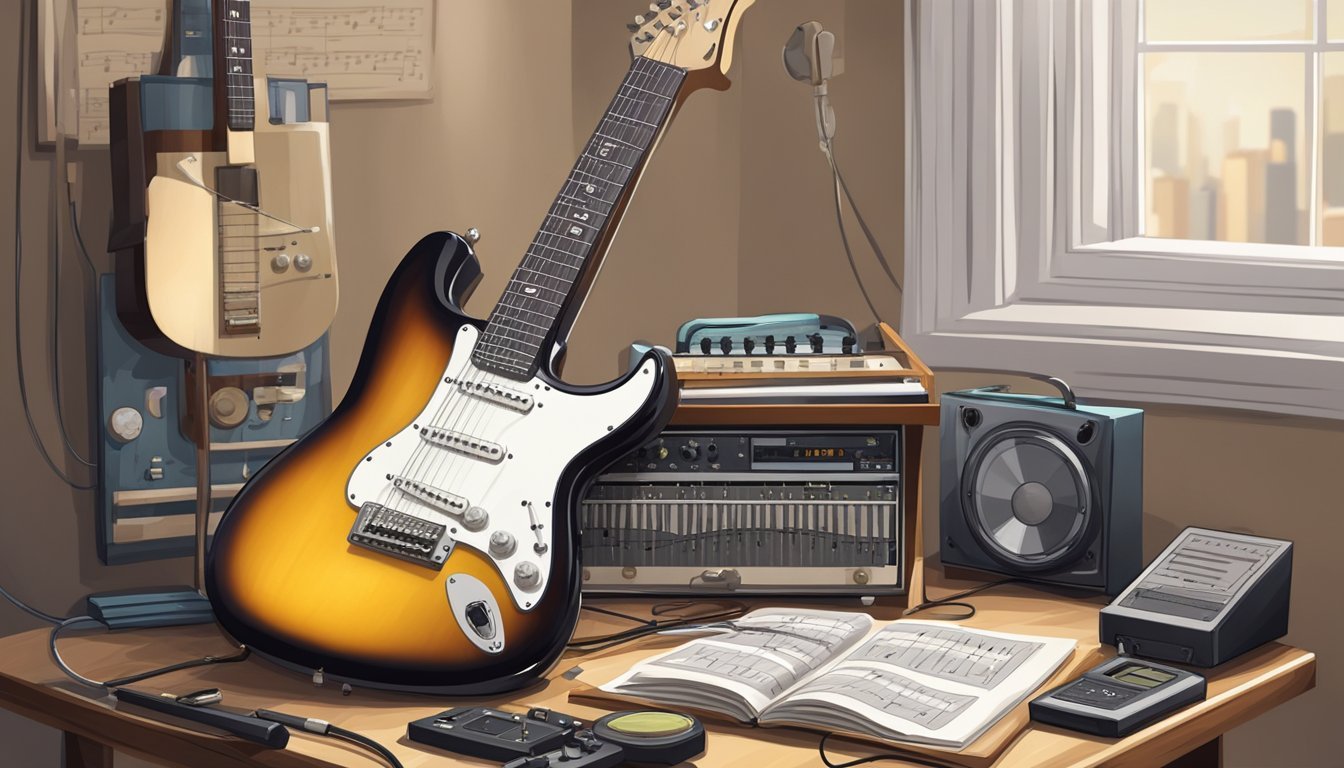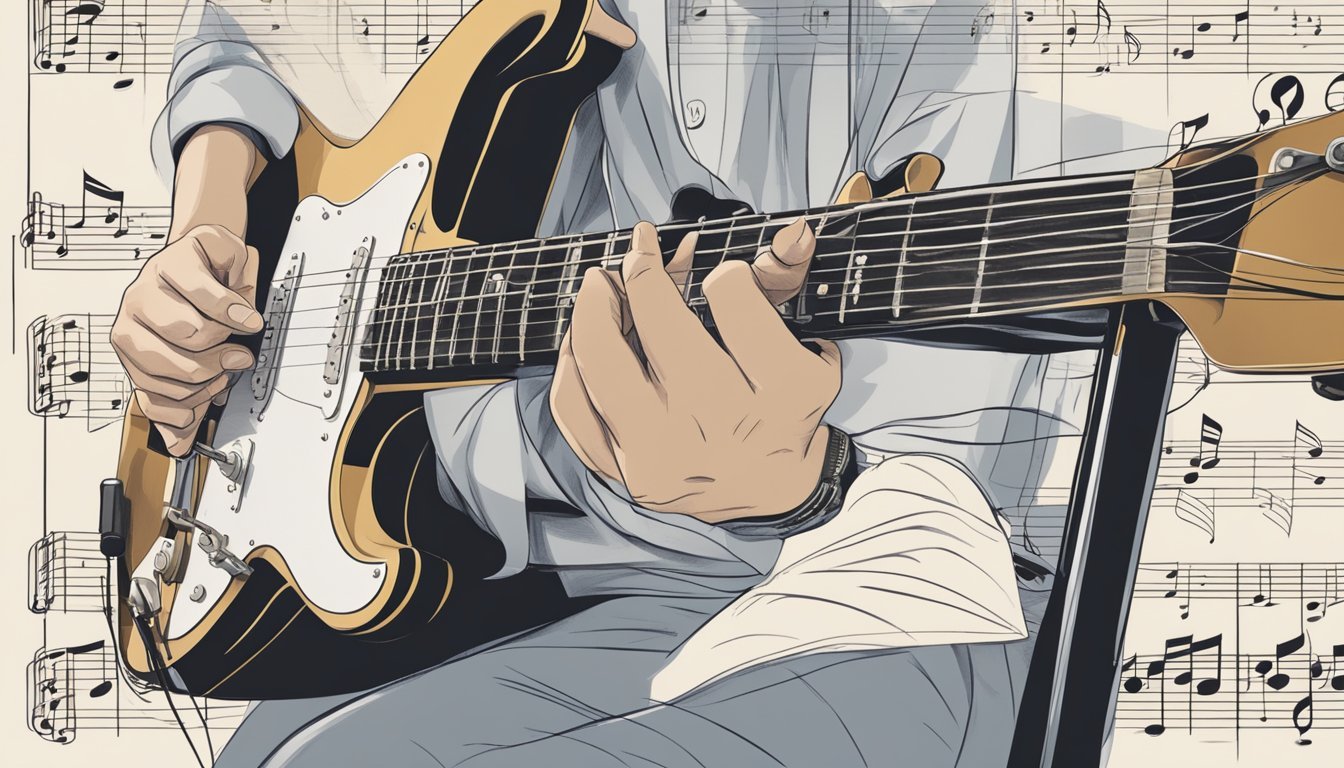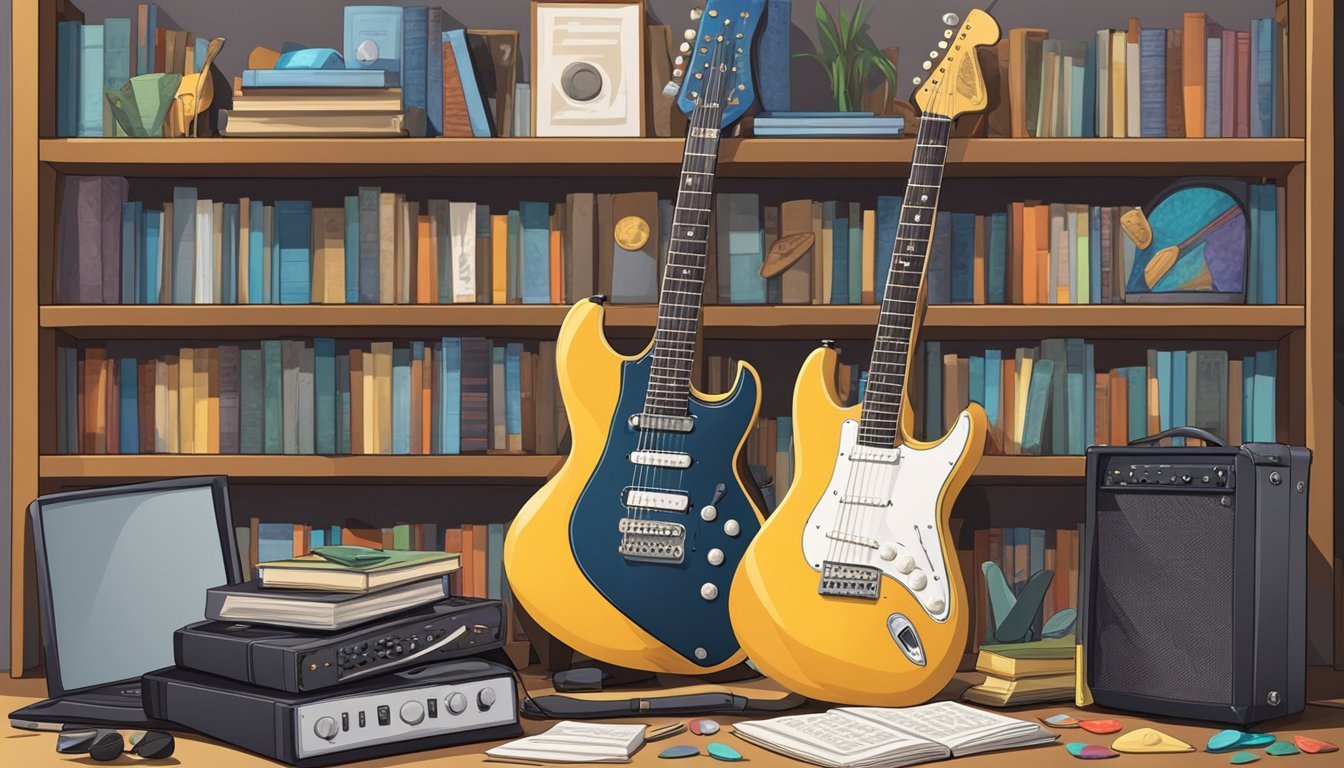Learning to play the electric guitar can be an exciting journey. Many beginners can pick up basic chords and play simple songs in just a few weeks with consistent practice.
Your timeline for becoming proficient depends on various factors, including your practice routine and the goals you set for yourself.

As you start, focusing on the fundamentals will lay a strong foundation for your progress.
Remember, motivation and dedication are key elements in your learning process.
As you advance, you’ll discover new techniques and styles that will keep you engaged and growing as a player.
Key Takeaways
- You can start playing simple songs within weeks of practice.
- Consistent effort and clear goals are vital for progress.
- Embracing the learning journey will enhance your skills over time.
Getting Started with the Electric Guitar

Starting your journey with the electric guitar can be exciting yet overwhelming.
You’ll want to focus on the right choices for your first instrument, get familiar with its parts, and gather essential gear to make your learning smooth.
Choosing Your First Electric Guitar
When selecting your first electric guitar, consider both budget and style.
Brands like Fender and Epiphone offer great entry-level options.
Try to find a guitar that feels comfortable in your hands and fits your style of music.
It’s helpful to choose a model that allows you to play basic chords easily.
Look for a guitar with a thin neck if you have smaller hands.
Don’t hesitate to check used models; they often provide good value.
Understanding Basic Guitar Anatomy
Knowing your guitar is key to becoming a better player.
The main parts include the body, neck, and headstock.
On the body, you’ll find the pickups, which capture the vibrations of your strings.
The neck houses the frets and fretboard, where you’ll press down to play different notes and chords, including basic open chords.
Lastly, the headstock has the tuning pegs to adjust string tension.
Understanding these parts will help you follow lessons better and troubleshoot any issues.
Essential Gear and Accessories
Besides the guitar, you need some basic gear to start playing.
A quality guitar tuner is crucial for keeping your instrument in tune.
You might also want a guitar strap for comfort while standing.
Other important accessories include a guitar pick and a set of extra strings.
If you play regularly, consider a guitar case to protect your instrument.
A simple practice amp can give you the right sound as you learn.
This gear will help ease the learning curve and make your practice sessions enjoyable.
Fundamentals of Guitar Playing
Getting started with guitar playing involves mastering some key skills.
You will focus on basic chords, strumming patterns, and building muscle memory.
These elements set the foundation for your musical journey.
Learning Basic Chords and Strumming Patterns
Begin with the most common chords like C, G, D, and E minor.
These chords form the basis of many songs.
You can find chord charts online that show you where to place your fingers.
Practice switching between these chords in different chord progressions.
Aim for smooth transitions; this will help you play songs more easily.
For strumming, start with simple patterns, like downstrokes.
Gradually add upstrokes to create a fuller sound.
Setting clear practice sessions will help you stay consistent.
Try to practice for at least 15-30 minutes daily.
Over time, you’ll feel more comfortable with both chords and strumming.
Developing Muscle Memory through Practice
Muscle memory is essential for any guitarist.
This term refers to your fingers learning where to go with repeated efforts.
The more you practice, the easier it’ll be to play chords accurately, without looking at your hands.
Start slow during your practice sessions.
Focus on accuracy rather than speed.
Once you feel confident, gradually increase your tempo.
This will help your fingers adjust and build strength.
Use a metronome to help you keep time and develop rhythm.
Practicing different tempos can greatly enhance your control and timing.
Believe it or not, muscle memory can significantly reduce mistakes while you play.
Mastering Barre Chords and Power Chords
Once you’ve got the basics down, it’s time to tackle barre chords and power chords.
Barre chords use one finger to press down multiple strings at once, which can be tricky at first.
Start on the low strings and gradually move to higher ones.
Power chords are often used in rock music and are fairly simple.
They only require two or three fingers.
They allow you to play a wide range of songs.
Practice them at varying speeds to get used to the finger placements.
Keep pushing your limits with regular practice.
You might stumble at first, but that’s part of the journey.
Over time, you’ll find these chords becoming second nature.
Advancing Your Skills

As you progress on your electric guitar journey, it’s time to explore new techniques and deepen your understanding of music.
Advancing your skills will help you express yourself better and play more complex pieces.
Let’s look at a few key areas you can focus on.
Exploring Guitar Techniques and Styles
To advance, start diving into different guitar techniques.
This can include:
- Fingerpicking: Use your fingers instead of a pick for a softer sound.
- Palm Muting: Lightly rest your palm on the strings to create a muffled sound during strumming.
- Alternate Picking: Practice picking both downwards and upwards for faster playing.
You should also explore various styles like rock, blues, or jazz.
Each style uses different techniques that can enhance your skill set.
Try learning famous riffs or songs from different genres to get a feel for each.
Integrating Music Theory into Practice
Understanding music theory will take your guitar playing to another level.
Start with the basics:
- Scales: Learn major and minor scales. They help with melody and improvisation.
- Chords: Understand how chords are built and how they work together.
A good way to integrate theory is through songwriting or improvisation.
Try to create your own melodies over familiar chord progressions.
This not only makes practice more fun but also reinforces what you’ve learned.
Advancing to Lead Guitar and Soloing
When you feel comfortable with the basics, it’s time to tackle lead guitar.
Focus on these key aspects:
- Improvisation: Use your knowledge of scales to create solos.
- Bending Notes: Practice bending strings to add emotion to your playing.
- Hammer-ons and Pull-offs: These techniques will make your playing more fluid and dynamic.
You can find backing tracks online to practice soloing over.
This helps you apply what you’ve learned while boosting your confidence.
As you advance, take the time to explore famous solos and try to play them.
This will help solidify your skills and push you further.
Practical Tips for Improvement
Improving your skills on electric guitar requires setting clear goals, using the right resources, and practicing regularly.
Here’s how you can enhance your learning experience effectively.
Setting Achievable Guitar Goals
Start by setting clear and realistic goals.
Think about what you want to achieve.
Maybe it’s learning a specific song or mastering a technique.
Break these big goals into smaller, manageable tasks.
For example, instead of saying, “I want to be a rock star,” aim for “I want to learn the intro to ‘Smoke on the Water’ this week.” This focused approach keeps you motivated and makes progress feel more attainable.
You can also track your progress.
Use a simple journal or an app to note what you learn each week.
Celebrate your milestones, no matter how small!
Utilizing Learning Resources Effectively
There are tons of resources available, from online guitar courses to apps and tutorials.
Choose materials that fit your skill level and learning style.
Consider starting with a reputable online guitar course.
These often offer structured lessons that cover everything from basics to advanced techniques.
Platforms like YouTube also have countless tutorials that can help you learn specific songs or techniques.
Don’t forget about books or instructional videos.
These can provide deeper insights into music theory or particular styles.
Explore different methods and find what resonates with you.
This way, you can build your musical knowledge effectively.
Maintaining Regular and Focused Practice Sessions
Regular practice is key to improving on the guitar.
Aim for shorter, focused sessions rather than long, exhausting ones.
Practicing for 30 minutes most days is more effective than a few hours once a week.
Create a simple practice schedule.
Dedicate time to warm-up exercises, song practice, and technique drills.
Use a timer to stay focused and take short breaks to keep your mind fresh.
Stay dedicated during your sessions.
Avoid distractions like your phone or TV.
This helps you maximize your practice hours and will make your musical journey smoother.
Frequently Asked Questions
Learning electric guitar comes with many questions.
You might wonder about realistic timelines, how self-teaching works, and other key details.
Let’s dive into some common queries.
Is it realistic to learn electric guitar in under a year?
Yes, it’s possible to learn electric guitar in under a year.
With consistent practice, many beginners can play their first songs and grasp basic skills within this time.
Just remember, your growth really depends on how much time and effort you put in.
Can someone become proficient in electric guitar by self-teaching?
Definitely! Many people teach themselves electric guitar successfully.
With the right resources, like online tutorials and practice materials, you can learn at your pace.
Just be sure to stay motivated and challenge yourself as you progress.
What’s the average time to master electric guitar for beginners?
For beginners, mastering electric guitar can take several years.
Many people reach a comfortable level within 1-2 years, but true mastery varies by individual.
Regular practice and dedicated learning help speed up this process.
While some may wonder how long to learn bass guitar, the journey often follows a similar path.
Like the electric guitar, consistent practice and a passion for music can significantly enhance progress.
Joining a group or taking lessons can also provide valuable feedback, making the learning experience more enjoyable and efficient.
Are chords or tabs easier for starters on electric guitar?
Chords are generally easier for newcomers to start with.
Learning basic chords lets you play many songs quickly.
Tabs can be great once you feel comfortable, providing a clear way to learn songs note by note.
How long before you can play songs on the electric guitar?
Most beginners can play simple songs within a few weeks of starting.
If you practice regularly, you’ll likely be playing your first full song in a couple of months.
The key is to choose songs that match your skill level.
Does learning the bass guitar differ much from the electric guitar in terms of time?
Learning bass guitar often takes a similar amount of time as learning the electric guitar.
Both require practice and patience.
Bass may focus more on rhythm and groove, so if you already play one, picking up the other can be a bit easier.

